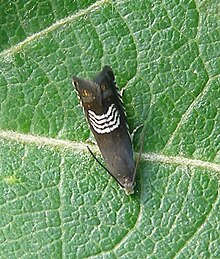Grapholita compositella
 From Wikipedia - Reading time: 4 min
From Wikipedia - Reading time: 4 min
| Grapholita compositella | |
|---|---|

| |
| Scientific classification | |
| Domain: | Eukaryota |
| Kingdom: | Animalia |
| Phylum: | Arthropoda |
| Class: | Insecta |
| Order: | Lepidoptera |
| Family: | Tortricidae |
| Genus: | Grapholita |
| Species: | G. compositella
|
| Binomial name | |
| Grapholita compositella (Fabricius, 1775)
| |
| Synonyms | |
| |
Grapholita compositella, the clover seed moth, is a moth of the family Tortricidae. It is found from Europe to Asia Minor, Mongolia, China and eastern Russia. It is also present in North America.

The wingspan is 8–10 mm. The face and palpi are white. The forewings are dark fuscous. The costa has eight long white strigulae, several ending in leaden-metallic marks.There is a slightly curved broad quadrate whitish median dorsal blotch, with three parallel blackish lines, surmounted by a leaden-metallic mark. The ocellus is represented by a leaden - metallic transverse mark. The hindwings in the male are white, the apex broadly fuscous ; in the femalethey are dark fuscous, lighter basally.[1]
There are two generations per year, with adults on wing in May and June and again in August. Males fly during the day, while females fly towards sunset.
The larvae feed on Trifolium species, including Trifolium pratense and Trifolium repens. They have also been recorded on Glycine max, Medicago sativa, Melilotus, Lotus corniculatus and other Leguminosae species.
References
[edit]- ^ Meyrick, E., 1895 A Handbook of British Lepidoptera MacMillan, London pdf
 This article incorporates text from this source, which is in the public domain. Keys and description
This article incorporates text from this source, which is in the public domain. Keys and description
External links
[edit]
 KSF
KSF